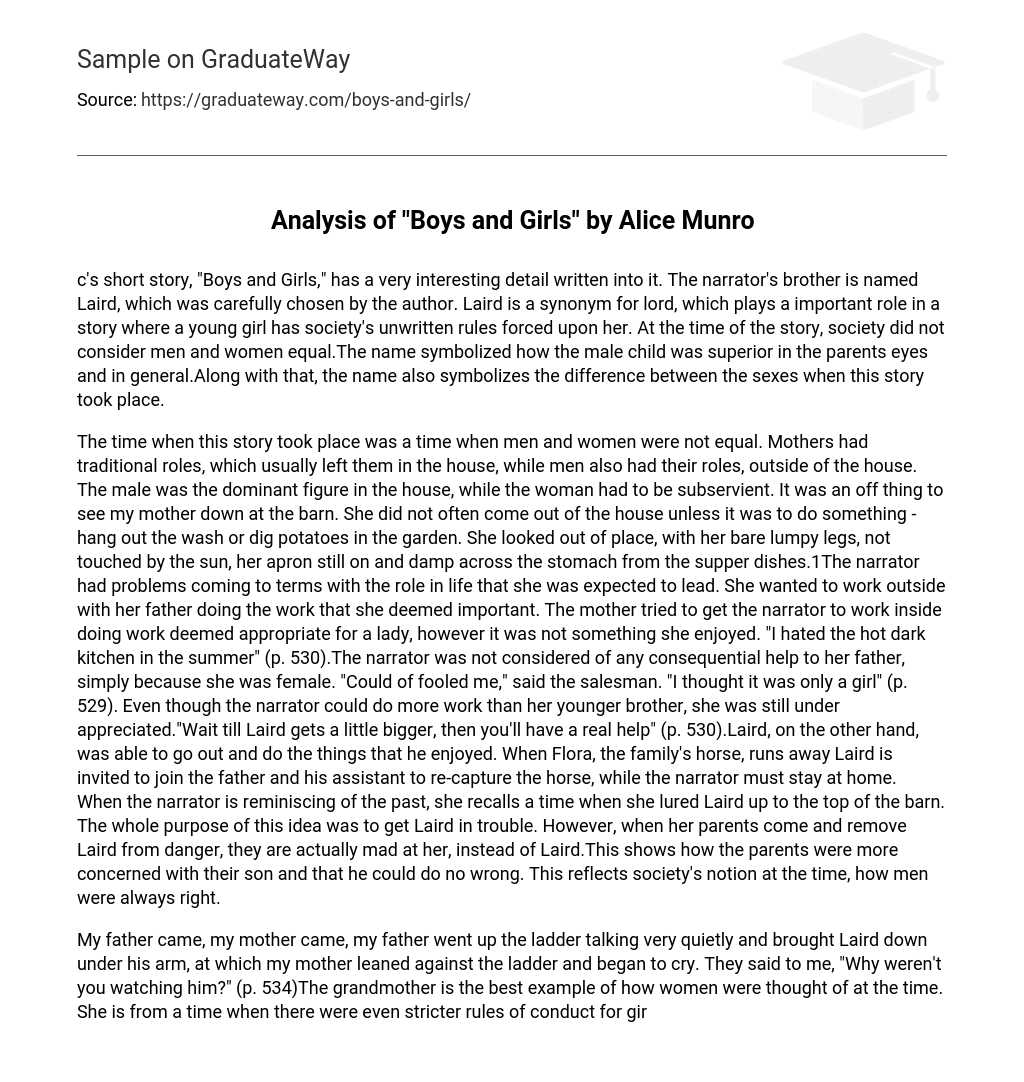The intriguing detail in the short story “Boys and Girls” is the deliberate choice of the narrator’s brother’s name as Laird. Laird, essentially a synonym for “lord,” carries significant meaning, highlighting the pivotal role where a young girl is subjected to society’s unspoken norms. During that era, gender equality was not widely acknowledged, and this name signifies how the male child was favored and considered superior by both parents and society at large. Additionally, it serves as a symbol for the stark contrast between genders during this period.
During this story’s time period, there was a significant gender inequality where men and women lacked equal status. Traditional gender roles confined mothers to their homes, while men had responsibilities outside the house. Within the household, males held dominance, while females were expected to be submissive. It was rare to see my mother at the barn as she seldom left home unless for specific tasks like laundry or tending to the garden. With her unseen pale legs and a wet apron over her stomach from washing dishes after supper, she seemed out of place in that setting.
The narrator struggled to accept the societal expectations placed on her and the role she was supposed to embody. She desired to engage in meaningful work outdoors with her father, rather than conforming to conventional feminine tasks indoors. Despite her mother’s efforts to guide her towards tasks deemed suitable for a lady, the narrator found no satisfaction in working inside. In fact, she despised the suffocating heat of the kitchen during summertime (p. 530).
The narrator faced gender discrimination from her father who did not consider her helpful because she was a girl. The salesman’s sarcastic remark, “Could of fooled me, I thought it was only a girl” (p. 529), emphasized this bias. Despite the fact that she could accomplish more work than her younger brother, she still didn’t receive proper appreciation. She was told to wait until Laird grew bigger for him to be considered a real help (p. 530). In contrast, Laird had the privilege of participating in activities he enjoyed. For instance, when their horse Flora ran away, Laird was included in the mission to capture her while the narrator had to stay at home. When looking back on past memories, the narrator recalled enticing Laird to climb up to the top of the barn.
The primary intention behind this concept was to cause trouble for Laird. However, when her parents intervene and rescue Laird from harm’s way, they end up blaming her instead of him. This highlights how the parents prioritized their son and believed he was incapable of any wrongdoing. This mirrors the prevailing belief in society during that period, where men were considered infallible.
When my father and mother arrived, my father ascended the ladder, speaking in hushed tones, and returned with Laird in his embrace. This caused my mother to lean against the ladder and shed tears. They asked me, “Why didn’t you keep an eye on him?” (p. 534) The grandmother serves as a prime illustration of how women were perceived during that era, as she hails from a period with even more stringent regulations for girls’ behavior.
The narrator’s parents have a more relaxed attitude compared to the grandmother but are significantly less outspoken. The grandmother expresses the ideas that were ingrained in her during childhood. In the time period of the story, girls were expected to be delicate and charming, while men were expected to be tough and adventurous. “Girls are not supposed to slam doors like that.” “Girls are expected to keep their knees together when they sit.” And even worse, when I asked certain questions, I was told, “That is not something girls should worry about.” Despite this, I continued to slam doors and sit in an intentionally awkward manner because I believed that doing so allowed me to maintain my freedom (p. 532).
The narrator, on the other hand, could not maintain her independence. Over time, she underwent a transformation and adopted the traits commonly associated with females. She started conforming to society’s expectations of women. Towards the conclusion of the tale, Laird begins to recognize his innate superiority as a male. He informs his parents about Flora’s escape from the yard and leans more towards his father’s guidance.
The speaker discussed Flora and mentioned shooting and dismembering her, which upset the speaker’s mother. The mother expressed her disapproval of this topic and instructed the speaker to clean himself before joining the family at the table. The father intervened and told the speaker to wash off the blood. These events highlight male dominance in society during that time. Despite listening to his mother’s complaints, the speaker only takes action when his father commands him to do so. This emphasizes the authoritative role of the father and positions the mother as secondary. Even the daughter holds a lower opinion of her compared to their father, claiming that she is unaware of reality.
“Boys and Girls” is set in a society devoid of gender equality, where men occupy dominant positions as heads of households and workers outside the home. Meanwhile, women are expected to prioritize domestic responsibilities and care for men. Throughout the story, the narrator undergoes a gradual acceptance of her prescribed societal role. The narrator’s brother serves as a symbol representing the contrasting gender roles prevalent in this society.
The narrator feels obligated to perform unpleasant tasks, specifically those associated with traditional women’s work during that era. In contrast, Laird has the liberty to pursue his own passions. Due to his male identity, Laird is considered more significant while the narrator is confined to her designated feminine role and regarded as less important.





